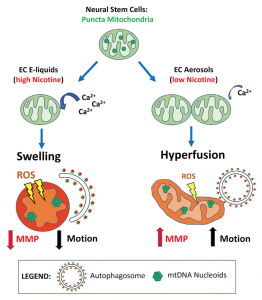68 5.14: Conclusion
Conclusion
In summary, although the pulmonary consequences of vaping are often emphasized, the study by Zahedi et al. demonstrated the potentially insidious effect of e-cigarettes on neural stem cells found within the brain. Although the causative mechanisms underlying vaping-related pathology are most likely numerous and variable (CDC), this study suggested that nicotine-containing e-liquids harm cells by impairing mitophagy through increasing the pH within autophagosomes, inducing oxidative stress, and initiating SIMH and mtDNA aggregation (Zahedi et al., 2019). This contributes to the growing body of research which cautions against the perceived “safety” of e-cigarettes (Zahedi et al.).

Thankfully, efforts are underway to raise awareness about the risks of vaping. On December 9, 2019, Toronto’s Medical Officer of Health, Dr. Eileen de Villa, will report on the health consequences of vaping and potential legislative actions to the Board of Health (Medical Officer of Health). Dr. de Villa’s recommendations include restricting the accessibility of flavoured vaping products and aligning laws governing e-cigarette sale and use with those for traditional cigarettes (Ngabo). By declaring e-cigarette related illnesses and deaths as a cause for concern (Ngabo), Dr. de Villa echoes Health Canada’s statement, which warns of the demonstrated risks yet unknown long term health consequences of vaping (“Vaping-associated lung illness”).
In the interim, as e-cigarette users and non-users alike await the scientific explanation behind vaping-related pathogenesis, the words of Hassan Nemeh, Henry Ford Hospital’s director of thoracic organ transplant surgery, ring clear: “This is an evil I haven’t faced before. The damage that these vapes do to people’s lungs is irreversible. Please think of that- and tell your children to think of that.” (qtd. in Associated Press).
